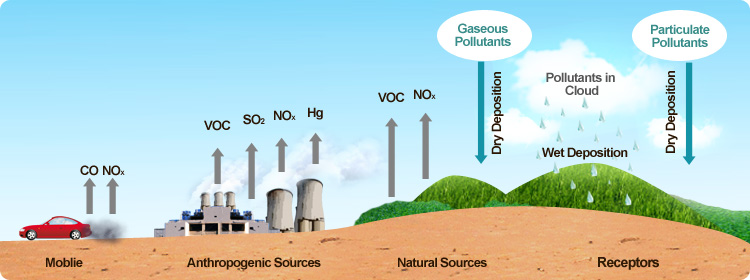ENERGY
Pollutants
Clean air is essential to life and good health. Air pollution aggravates asthma, a popular children's illness. Air pollution also causes disease and even premature death among vulnerable populations, including children, the elderly, and people with lung disease.
The two main sources of pollutants in urban areas are transportation (predominantly automobiles) and fuel combustion in stationary sources, including residential, commercial, and industrial heating and cooling and coal-burning power plants. Motor vehicles produce high levels of carbon monoxides (CO) and a major source of nitrogen oxides (NOx). Whereas, fuel combustion in stationary sources is the dominant source of sulphur dioxide (SO2).

Currently, fossil fuels supply about 86% of the global primary energy consumption for transportation, industrial, commercial and residential uses. Due to the combustion of fossil fuels, large quantities of pollutants are emitted into the air, which have serious impact on the local, regional and global air quality. The followings are a brief description of the air pollutants and their impacts:
- Sulphur dioxide
Sulphur dioxide (SO2) comes from the combustion of fuel containing sulphur, mostly coal and oil. It is also produced during metal melting and other industrial processes. Together, SO2 and NOx are the major precursors to acid rain, which is associated with the acidification of lakes and streams, accelerated corrosion of buildings and monuments, and reduced visibility. - Nitrogen oxides
Nitrogen oxides (NOX) are emitted by burning fossil fuels at electric power plants and in automobiles. Nitrogen oxides are an important precursor to both ozone and acid rain and can affect both land and water ecosystems. NO2 is formed primarily from nitric oxide emitted from combustion sources. It is also a product of photochemical smog. Both nitrogen oxides and ozone can irritate the lungs, cause bronchitis and pneumonia, and decrease resistance to respiratory infections.
Other air pollutants
Burning fossil fuels, especially coal and oil, produces a host of other air pollutants in addition to those discussed above. Among them are:
- Carbon monoxide
Carbon monoxide (CO) is a colorless, odorless gas that is formed when carbon in fuel is not burned completely. It is a component of motor vehicle exhaust, Higher levels of CO generally occur in areas with heavy traffic congestion. Other sources of CO emissions include industrial processes (such as metals processing and chemical manufacturing), residential wood burning, and natural sources such as forest fires. - Ozone
Ozone is formed under a complex chain of chemical reactions in the presence of sunlight and warm temperatures involving a host of precursors, the key ones being oxygen, nitrogen oxides (NOx), and reactive volatile organic compounds (VOC). Common VOC sources include paints and VOC containing domestic products for household and cosmetic use. - Mercury
Mercury is a heavy metal that is discharged into the air and exists in our lakes, streams, and ultimately accumulates in our bodies through inhalation, drinking or eating. The largest sources of mercury in the environment are coal-fired power plants, medical waste and municipal waste incinerators. - Respirable Suspended Particulates (RSP)
RSP comprises particles with a nominal aerodynamic diameter of 10 micrometers or less. Others, such as sulphates and nitrates, are formed from sulphur dioxide and NOx, as they get involved in chemical reactions in the atmosphere.
















